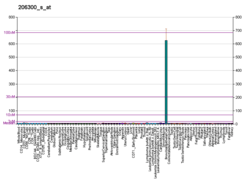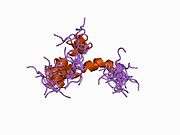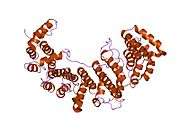Parathyroid hormone-related protein
Parathyroid hormone-related protein (or PTHrP) is a protein member of the parathyroid hormone family secreted by mesenchymal stem cells. It is occasionally secreted by cancer cells (breast cancer, certain types of lung cancer including squamous-cell lung carcinoma). However, it also has normal functions in bone, tooth, vascular and other tissues.
Function
PTHrP acts as an endocrine, autocrine, paracrine, and intracrine hormone. It regulates endochondral bone development by maintaining the endochondral growth plate at a constant width. It also regulates epithelial–mesenchymal interactions during the formation of the mammary glands.
Tooth eruption
PTHrP is critical in intraosseous phase of tooth eruption where it acts as a signalling molecule to stimulate local bone resorption. Without PTHrP, the bony crypt surrounding the tooth follicle will not resorb, and therefore the tooth will not erupt. In the context of tooth eruption, PTHrP is secreted by the cells of the reduced enamel epithelium.
Mammary glands
It aids in normal mammary gland development.[4][5] It is necessary for maintenance of the mammary bud. Loss of PTHrP or its receptor causes the mammary bud cell fate to change back into epidermis. In lactation, it may regulate in conjunction with the calcium sensing receptor the mobilization and transfer of calcium to the milk, as well as placental transfer of calcium.
Humoral hypercalcemia of malignancy
PTHrP is related in function to the "normal" parathyroid hormone. When a tumor secretes PTHrP, this can lead to hypercalcemia.[6] As this is sometimes the first sign of the malignancy, hypercalcemia caused by PTHrP is considered a paraneoplastic phenomenon. PTHR1 is responsible for most cases of humoral hypercalcemia of malignancy.
PTHrP shares the same N-terminal end as parathyroid hormone and therefore it can bind to the same receptor, the Type I PTH receptor (PTHR1). PTHrP can simulate most of the actions of PTH including increases in bone resorption and distal tubular calcium reabsorption, and inhibition of proximal tubular phosphate transport. PTHrP lacks the normal feedback inhibition as PTH. [7]
However, PTHrP is less likely than PTH to stimulate 1,25-dihydroxyvitamin D production. Therefore, PTHrP does not increase intestinal calcium absorption.
Genetics
Four alternatively spliced transcript variants encoding two distinct isoforms have been observed. There is also evidence for alternative translation initiation from non-AUG (CUG and GUG) start sites, in-frame and downstream of the initiator AUG codon, to give rise to nuclear forms of this hormone.[8]
Discovery
The protein was first isolated in 1987 by T. J. Martin's team at the University of Melbourne. Miao et al. showed that disruption of the PTHrP gene in mice caused a lethal phenotype and distinct bone abnormalities, suggesting that PTHrP has a physiological function.
Interactions
Parathyroid hormone-related protein has been shown to interact with KPNB1[9][10] and Arrestin beta 1.[11]
See also
- Analogs used as pharmaceutical drugs
References
- GRCh38: Ensembl release 89: ENSG00000087494 - Ensembl, May 2017
- "Human PubMed Reference:". National Center for Biotechnology Information, U.S. National Library of Medicine.
- "Mouse PubMed Reference:". National Center for Biotechnology Information, U.S. National Library of Medicine.
- Hens JR, Dann P, Zhang JP, Harris S, Robinson GW, Wysolmerski J (March 2007). "BMP4 and PTHrP interact to stimulate ductal outgrowth during embryonic mammary development and to inhibit hair follicle induction". Development. 134 (6): 1221–30. doi:10.1242/dev.000182. PMID 17301089.
- Hens JR, Wysolmerski JJ (2005). "Key stages of mammary gland development: molecular mechanisms involved in the formation of the embryonic mammary gland". Breast Cancer Research. 7 (5): 220–4. doi:10.1186/bcr1306. PMC 1242158. PMID 16168142.
- Broadus AE, Mangin M, Ikeda K, Insogna KL, Weir EC, Burtis WJ, Stewart AF (September 1988). "Humoral hypercalcemia of cancer. Identification of a novel parathyroid hormone-like peptide". The New England Journal of Medicine. 319 (9): 556–63. doi:10.1056/NEJM198809013190906. PMID 3043221.
- Stewart, Andrew F. (2005-01-27). "Clinical practice. Hypercalcemia associated with cancer". The New England Journal of Medicine. 352 (4): 373–379. doi:10.1056/NEJMcp042806. ISSN 1533-4406. PMID 15673803.
- "Entrez Gene: PTHLH parathyroid hormone-like hormone".
- Cingolani G, Bednenko J, Gillespie MT, Gerace L (December 2002). "Molecular basis for the recognition of a nonclassical nuclear localization signal by importin beta". Molecular Cell. 10 (6): 1345–53. doi:10.1016/S1097-2765(02)00727-X. PMID 12504010.
- Lam MH, Hu W, Xiao CY, Gillespie MT, Jans DA (March 2001). "Molecular dissection of the importin beta1-recognized nuclear targeting signal of parathyroid hormone-related protein". Biochemical and Biophysical Research Communications. 282 (2): 629–34. doi:10.1006/bbrc.2001.4607. PMID 11401507.
- Conlan LA, Martin TJ, Gillespie MT (September 2002). "The COOH-terminus of parathyroid hormone-related protein (PTHrP) interacts with beta-arrestin 1B". FEBS Letters. 527 (1–3): 71–5. doi:10.1016/S0014-5793(02)03164-2. PMID 12220636.
Further reading
- Miao D, Li J, Xue Y, Su H, Karaplis AC, Goltzman D (August 2004). "Parathyroid hormone-related peptide is required for increased trabecular bone volume in parathyroid hormone-null mice". Endocrinology. 145 (8): 3554–62. doi:10.1210/en.2003-1695. PMID 15090463.
- Casey ML, MacDonald PC (October 1996). "The endothelin-parathyroid hormone-related protein vasoactive peptide system in human endometrium: modulation by transforming growth factor-beta". Human Reproduction. 11 Suppl 2: 62–82. doi:10.1093/humrep/11.suppl_2.62. PMID 8982748.
- Lam MH, Thomas RJ, Martin TJ, Gillespie MT, Jans DA (August 2000). "Nuclear and nucleolar localization of parathyroid hormone-related protein". Immunology and Cell Biology. 78 (4): 395–402. doi:10.1046/j.1440-1711.2000.00919.x. PMID 10947864.
- Fiaschi-Taesch NM, Stewart AF (February 2003). "Minireview: parathyroid hormone-related protein as an intracrine factor--trafficking mechanisms and functional consequences". Endocrinology. 144 (2): 407–11. doi:10.1210/en.2002-220818. PMID 12538599.
- Jans DA, Thomas RJ, Gillespie MT (2003). "Parathyroid hormone-related protein (PTHrP): a nucleocytoplasmic shuttling protein with distinct paracrine and intracrine roles". Vitamins & Hormones. 66: 345–84. doi:10.1016/S0083-6729(03)01010-0. ISBN 978-0-12-709866-1. PMID 12852260. Cite journal requires
|journal=(help) - Maioli E, Fortino V, Pacini A (December 2004). "Parathyroid hormone-related protein in preeclampsia: a linkage between maternal and fetal failures". Biology of Reproduction. 71 (6): 1779–84. doi:10.1095/biolreprod.104.030932. PMID 15286039.
- Fenton AJ, Kemp BE, Kent GN, Moseley JM, Zheng MH, Rowe DJ, Britto JM, Martin TJ, Nicholson GC (October 1991). "A carboxyl-terminal peptide from the parathyroid hormone-related protein inhibits bone resorption by osteoclasts". Endocrinology. 129 (4): 1762–8. doi:10.1210/endo-129-4-1762. PMID 1915066.
- Fenton AJ, Kemp BE, Hammonds RG, Mitchelhill K, Moseley JM, Martin TJ, Nicholson GC (December 1991). "A potent inhibitor of osteoclastic bone resorption within a highly conserved pentapeptide region of parathyroid hormone-related protein; PTHrP[107-111]". Endocrinology. 129 (6): 3424–6. doi:10.1210/endo-129-6-3424. PMID 1954916.
- Moniz C, Burton PB, Malik AN, Dixit M, Banga JP, Nicolaides K, Quirke P, Knight DE, McGregor AM (December 1990). "Parathyroid hormone-related peptide in normal human fetal development". Journal of Molecular Endocrinology. 5 (3): 259–66. doi:10.1677/jme.0.0050259. PMID 2288637.
- Hammonds RG, McKay P, Winslow GA, Diefenbach-Jagger H, Grill V, Glatz J, Rodda CP, Moseley JM, Wood WI, Martin TJ (September 1989). "Purification and characterization of recombinant human parathyroid hormone-related protein". The Journal of Biological Chemistry. 264 (25): 14806–11. PMID 2549037.
- Yasuda T, Banville D, Hendy GN, Goltzman D (May 1989). "Characterization of the human parathyroid hormone-like peptide gene. Functional and evolutionary aspects". The Journal of Biological Chemistry. 264 (13): 7720–5. PMID 2708388.
- Suva LJ, Mather KA, Gillespie MT, Webb GC, Ng KW, Winslow GA, Wood WI, Martin TJ, Hudson PJ (April 1989). "Structure of the 5' flanking region of the gene encoding human parathyroid-hormone-related protein (PTHrP)". Gene. 77 (1): 95–105. doi:10.1016/0378-1119(89)90363-6. PMID 2744490.
- Mangin M, Webb AC, Dreyer BE, Posillico JT, Ikeda K, Weir EC, Stewart AF, Bander NH, Milstone L, Barton DE (January 1988). "Identification of a cDNA encoding a parathyroid hormone-like peptide from a human tumor associated with humoral hypercalcemia of malignancy". Proceedings of the National Academy of Sciences of the United States of America. 85 (2): 597–601. doi:10.1073/pnas.85.2.597. PMC 279598. PMID 2829195.
- Moseley JM, Kubota M, Diefenbach-Jagger H, Wettenhall RE, Kemp BE, Suva LJ, Rodda CP, Ebeling PR, Hudson PJ, Zajac JD (July 1987). "Parathyroid hormone-related protein purified from a human lung cancer cell line". Proceedings of the National Academy of Sciences of the United States of America. 84 (14): 5048–52. doi:10.1073/pnas.84.14.5048. PMC 305244. PMID 2885845.
- Mangin M, Ikeda K, Dreyer BE, Broadus AE (April 1989). "Isolation and characterization of the human parathyroid hormone-like peptide gene". Proceedings of the National Academy of Sciences of the United States of America. 86 (7): 2408–12. doi:10.1073/pnas.86.7.2408. PMC 286922. PMID 2928340.
- Thiede MA, Strewler GJ, Nissenson RA, Rosenblatt M, Rodan GA (July 1988). "Human renal carcinoma expresses two messages encoding a parathyroid hormone-like peptide: evidence for the alternative splicing of a single-copy gene". Proceedings of the National Academy of Sciences of the United States of America. 85 (13): 4605–9. doi:10.1073/pnas.85.13.4605. PMC 280483. PMID 3290897.
- Suva LJ, Winslow GA, Wettenhall RE, Hammonds RG, Moseley JM, Diefenbach-Jagger H, Rodda CP, Kemp BE, Rodriguez H, Chen EY (August 1987). "A parathyroid hormone-related protein implicated in malignant hypercalcemia: cloning and expression". Science. 237 (4817): 893–6. doi:10.1126/science.3616618. PMID 3616618.
- Campos RV, Zhang L, Drucker DJ (December 1994). "Differential expression of RNA transcripts encoding unique carboxy-terminal sequences of human parathyroid hormone-related peptide". Molecular Endocrinology. 8 (12): 1656–66. doi:10.1210/me.8.12.1656. PMID 7708054.
- Holick MF, Ray S, Chen TC, Tian X, Persons KS (August 1994). "A parathyroid hormone antagonist stimulates epidermal proliferation and hair growth in mice". Proceedings of the National Academy of Sciences of the United States of America. 91 (17): 8014–6. doi:10.1073/pnas.91.17.8014. PMC 44535. PMID 8058749.
- Seitz PK, Cooper KM, Ives KL, Ishizuka J, Townsend CM, Rajaraman S, Cooper CW (September 1993). "Parathyroid hormone-related peptide production and action in a myoepithelial cell line derived from normal human breast". Endocrinology. 133 (3): 1116–24. doi:10.1210/en.133.3.1116. PMID 8396010.
- Li H, Seitz PK, Selvanayagam P, Rajaraman S, Cooper CW (June 1996). "Effect of endogenously produced parathyroid hormone-related peptide on growth of a human hepatoma cell line (Hep G2)". Endocrinology. 137 (6): 2367–74. doi:10.1210/en.137.6.2367. PMID 8641188.
This article incorporates text from the United States National Library of Medicine, which is in the public domain.






